Canute: Danish King of England
Canute was the second and most famous King of Denmark, England, and Norway. A Dane by birth, he gained the throne of England first, in 1016, and then ruled all three kingdoms from 1028 to his death in 1035. 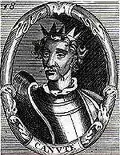
Canute (also called Cnut) was born in 995, the son of another English monarch, Sweyn Forkbeard, who was on the English throne briefly at the end of 1013 and the beginning of 1014 and also ruled both Denmark and Norway at that time. Historians differ on the identity of Canute's mother. Not much is known of Canute's early life. He is known to have married Ælfgifu of Northampton in 1013. He is mentioned as accompanying his father in an invasion of England in that same year, in response to a series of killings of Danes ordered by England's King Æthelred II and known as the St. Brice's Day Massacre. Sweyn's invasion was wildly successful, forcing »thelred to flee to Normandy, after which Sweyn took the English throne and Canute was put in charge of the Danish forces at Gainsborough. Sweyn had been declared king just before Christmas in 1013. He died on February 3, 1014, and yet another succession struggle ensued. The people of the Danelaw declared Canute their king. The English nobles, in the person of the advisory council Witangemot, had other ideas and recalled Æthelred from Normandy. The former king returned at the head of a large army and convinced Canute to return to Denmark. 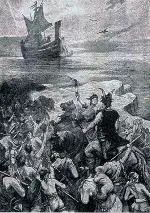
Canute set about building another invasion fleet, and this he launched in summer 1015. This fleet was notable in that its Vikings came from all over Scandinavia. The series of battles that followed are noted in chronicles of the time for their ferocity. Canute landed at Sandwich and stormed around Kent to target Wessex, the largest of the Anglo-Saxon kingdoms. The Vikings harried Dorset, Somerset, and Wiltshire, and Canute turned his focus to Wessex. He forced the submission of Wessex in late 1015, prompting a few of Æthelred's trusted allied to switch sides. The struggles continued into 1016. King Æthelred died on April 23, and his son, Edmund Ironside, succeeded him on the throne. By this time, he wasn't king of very much. Edmund struggled on, but Canute had the upper hand. The Dane took Northumbria and then returned south, to target Edmund, who had left the walls of London in order to try to build a new army in Wessex. Canute took London in the meantime, and the two armies parried and thrusted for several more weeks. Edmund had some brief success in retaking London, driving the Danes into Kent. After the English victory at Otford, one of the defectors, Eadric Streona, switched sides again. Canute avoided direct battle, moving to Essex and then Mercia. 
Edmund moved on Canute's forces again, and the result was the pivotal Battle of Ashingdon, on October 18, 1016. In the midst of the fray, Eadric Streona left the field of battle. Canute seized the opportunity and forced Edmund to flee. Canute, in hot pursuit, forced Edmund to fight near the Forest of Dean. Edmund had been wounded. He and Canute met on Olney, an island near Deerhurst, to discuss a truce. The two rulers split England in a north-south pattern, with the River Thames the dividing line, Canute getting the north and Edmund getting the south. Edmund agreed that Canute was the heir to the south. Canute followed through on this on November 30 when Edmund died. Canute was crowned King of England in 1017. To ensure that he avoided the kind of uprising that had plagued his father, he eliminated the oldest surviving son of Æthelred, Eadwig Ætheling, and convinced his other sons to stay in Normandy with their mother, Emma. Canute also convinced Edmund Ironside's sons to leave the country and not come back. Another thing that Canute did in order to secure peace in his new realm initially was continue to pay the Danegeld, a payment begun by his predecessors as a means of convincing Viking raiders not to attack. His payment was the largest ever recorded. Even though he himself was a Viking, Canute thought the payment necessary in order to keep the peace. It did, for a time. Canute succeeded Æthelred as the husband of Emma in June 1017 (setting aside his first wife, Ælfgifu), and the couple had a son named Hardacanute. Canute devolved rule of some kingdoms to warriors who had supported him: Thorkell the Tall (who had supported Æthelred originally but had switched sides) got East Anglia, Eadric Streona got Mercia, and Erik of Hlathir (Canute's brother-in-law) got Northumbria. Wessex Canute kept for himself, ruling it personally until the 1030s, when he established an earldom overseen by the powerful Sussex baron Godwin (whose son Harold Godwinson would become King Harold II). 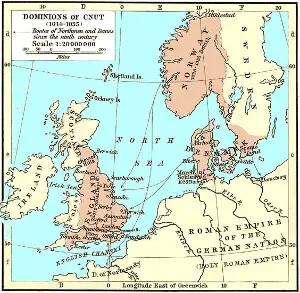
Emboldened by his success, Canute took it on himself to invade Scotland. He encountered an alliance of Scotland's King Malcolm II and King Owen the Bald of Strathcylde, and the result, at the Battle of Carham in 1018, was a rare defeat for the Dane. After his brother, Harald II died, Canute went to Denmark to take the throne there and returned to England in 1020, appointing his brother-inlaw, Ulf Jarl, as regent in Denmark. After a successful invasion and the submission of Olar Haraldsson, Canute was crowned King of Denmark. He later become King of Norway. His status as leader of the Viking kingdoms and of England protected the latter from raids by the former for a few decades, giving England time to recover from a few centuries of strife. In 1030, he sent his first wife, Ælfgifu, and his oldest son, Sveinn Knuttson, to rule Norway in his stead. 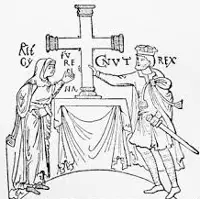
Canute very much wanted to be regarded as an English king, despite his origins. He routinely visited shrines dedicated to previous English kings, including Shaftesbury Abbey, the last resting place of Edward the Martyr and even Glastonbury Abbey, where his old enemy Edmund Ironside was buried. Canute also adopted a new legal code and based it on those of Edgar the Peaceful. Known as a pious king, Canute gave a lot of money to the church and directed a number of churches to be founded. He directed the church to be largely exempt from the sometimes high taxation that inflicted on the rest of the country. He also made a pilgrimage to Rome, in 1027, to meet with other European leaders there for the coronation of Conrad II as Holy Roman Emperor; Canute had an audience with Pope John XIX. He was also known to have done penance for his predecessors' violence toward England. 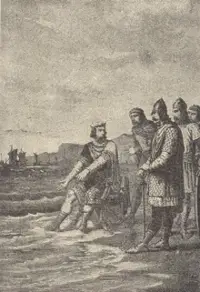
Canute is well-known for a story that may or may not have happened but is reported in many a historical source all the same. Many of his supporters had referred to this King of England, Denmark, and Norway as so great that he could command the tides of the sea to go back. Seeing, as the story goes, an opportunity to demonstrate his understanding of man's place within the greater story of religion, specifically Christianity, Canute had his throne dragged to the seashore, where he sat on it and commanded the tide not to come in. The tide did not obey. With the waves lapping around his feet, Canute is said to have something like this: "Let all men know how empty and worthless is the power of kings. For there is none worthy of the name but God, whom heaven, earth and sea obey." Canute died on Nov. 12, 1035 and was buried in Winchester. His son Hardacanute succeeded him on his various thrones. In England, however, Canute's second-oldest son, Harold Harefoot, was made regent because Hardacanute had to put down a rebellion in Denmark. The rebellion dragged on, and Harold was crowned King of England in 1037. He ruled until he died, in 1040. Hardacanute returned at this time and was proclaimed King of England. He ruled for two years and, on his death, was succeeded by Edward the Confessor. |
|
Social Studies for Kids
copyright 2002–2024
David White




